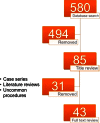A systematic review of comparative studies on bone graft alternatives for common spine fusion procedures
- PMID: 23440339
- PMCID: PMC3676568
- DOI: 10.1007/s00586-013-2718-4
A systematic review of comparative studies on bone graft alternatives for common spine fusion procedures
Abstract
Background: The increased prevalence of spinal fusion surgery has created an industry focus on bone graft alternatives. While autologous bone graft remains the gold standard, the complications and morbidity from harvesting autologous bone drives the search for reliable and safe bone graft substitutes. With the recent information about the adverse events related to bone morhogenetic protein use, it is appropriate to review the literature about the numerous products that are not solely bone morphogenetic protein.
Purpose: The purpose of this literature review is to determine the recommendations for use of non-bone morphogenetic protein bone graft alternatives in the most common spine procedures based on a quantifiable grading system.
Study design: Systematic literature review.
Methods: A literature search of MEDLINE (1946-2012), CINAHL (1937-2012), and the Cochrane Central Register of Controlled Trials (1940-April 2012) was performed, and this was supplemented by a hand search. The studies were then evaluated based on the Guyatt criteria for quality of the research to determine the strength of the recommendation.
Results: In this review, more than one hundred various studies on the ability of bone graft substitutes to create solid fusions and good patient outcomes are detailed.
Conclusion: The recommendations for use of bone graft substitutes and bone graft extenders are based on the strength of the studies and given a grade.
Figures
Similar articles
-
Osteoconductive bone graft extenders in posterolateral thoracolumbar spinal fusion: a systematic review.Spine (Phila Pa 1976). 2012 Jul 15;37(16):E993-1000. doi: 10.1097/BRS.0b013e3182518859. Spine (Phila Pa 1976). 2012. PMID: 22414999 Review.
-
What bone graft substitutes should we use in post-traumatic spinal fusion?Injury. 2011 Sep;42 Suppl 2:S64-71. doi: 10.1016/j.injury.2011.06.200. Epub 2011 Aug 15. Injury. 2011. PMID: 21839997
-
Current use of biologic graft extenders for spinal fusion.J Neurosurg Sci. 2012 Sep;56(3):203-7. J Neurosurg Sci. 2012. PMID: 22854588 Review.
-
Synthetic bone graft versus autograft or allograft for spinal fusion: a systematic review.J Neurosurg Spine. 2016 Oct;25(4):509-516. doi: 10.3171/2016.1.SPINE151005. Epub 2016 May 27. J Neurosurg Spine. 2016. PMID: 27231812 Review.
-
A post-market surveillance analysis of the safety of hydroxyapatite-derived products as bone graft extenders or substitutes for spine fusion.Eur Rev Med Pharmacol Sci. 2015 Oct;19(19):3548-55. Eur Rev Med Pharmacol Sci. 2015. PMID: 26502842
Cited by
-
Four-point bending as a method for quantitatively evaluating spinal arthrodesis in a rat model.Comp Med. 2015 Feb;65(1):46-50. Comp Med. 2015. PMID: 25730756 Free PMC article.
-
Effect of different hydroxyapatite incorporation methods on the structural and biological properties of porous collagen scaffolds for bone repair.J Anat. 2015 Dec;227(6):732-45. doi: 10.1111/joa.12262. Epub 2014 Nov 20. J Anat. 2015. PMID: 25409684 Free PMC article.
-
Platelet concentrates in spine fusion: meta-analysis of union rates and complications in controlled trials.Eur Spine J. 2016 May;25(5):1474-1483. doi: 10.1007/s00586-015-4193-6. Epub 2015 Aug 23. Eur Spine J. 2016. PMID: 26298478 Review.
-
Anterior Cervical Discectomy and Fusion Performed Using a CaO-SiO2-P2O5-B2O3 Bioactive Glass Ceramic or Polyetheretherketone Cage Filled with Hydroxyapatite/β-Tricalcium Phosphate: A Prospective Randomized Controlled Trial.J Clin Med. 2023 Jun 15;12(12):4069. doi: 10.3390/jcm12124069. J Clin Med. 2023. PMID: 37373762 Free PMC article.
-
Comparative evaluation of multi-fold rib and structural iliac bone grafts in single-segment thoracic and thoracolumbar spinal tuberculosis: clinical and radiological outcomes.J Orthop Surg Res. 2023 Dec 1;18(1):917. doi: 10.1186/s13018-023-04416-x. J Orthop Surg Res. 2023. PMID: 38041140 Free PMC article.
References
-
- Bono CM, Lee CK (2004) Critical analysis of trends in fusion for degenerative disc disease over the past 20 years: influence of technique on fusion rate and clinical outcome. Spine (Phila Pa 1976) 29(4):455–463; discussion Z455. pii:00007632-200402150-00019 - PubMed
-
- Dawson EG, Lotysch M, 3rd, Urist MR. Intertransverse process lumbar arthrodesis with autogenous bone graft. Clin Orthop Relat Res. 1981;154:90–96. - PubMed
-
- Dodd CA, Fergusson CM, Freedman L, Houghton GR, Thomas D. Allograft versus autograft bone in scoliosis surgery. J Bone Joint Surg Br. 1988;70(3):431–434. - PubMed
Publication types
MeSH terms
Substances
LinkOut - more resources
Full Text Sources
Other Literature Sources
Medical
Miscellaneous


